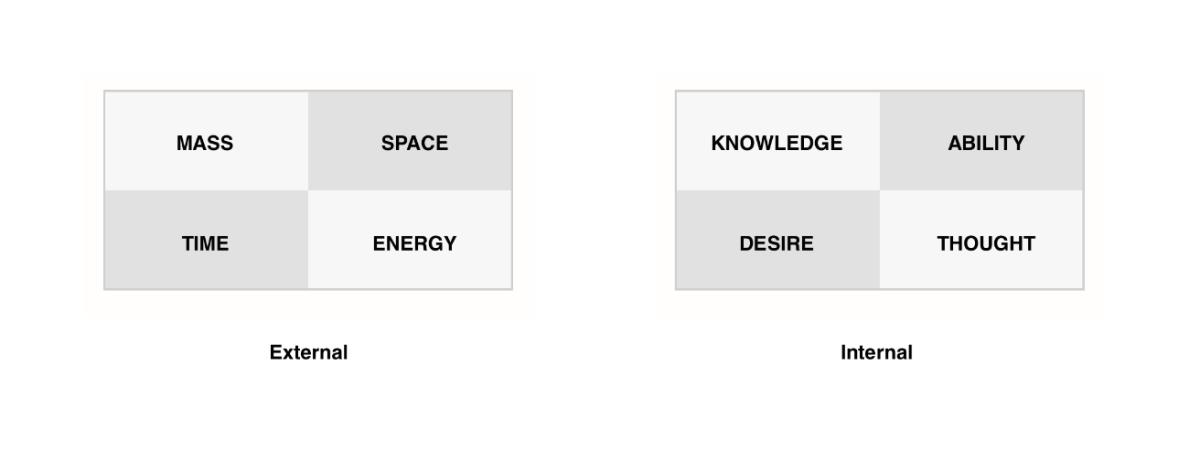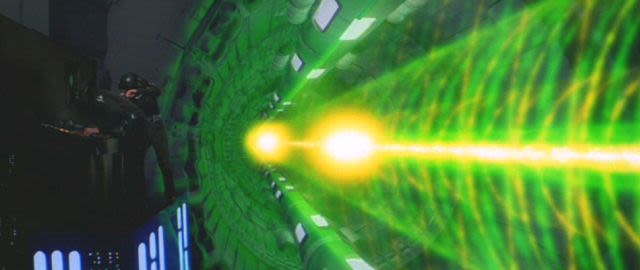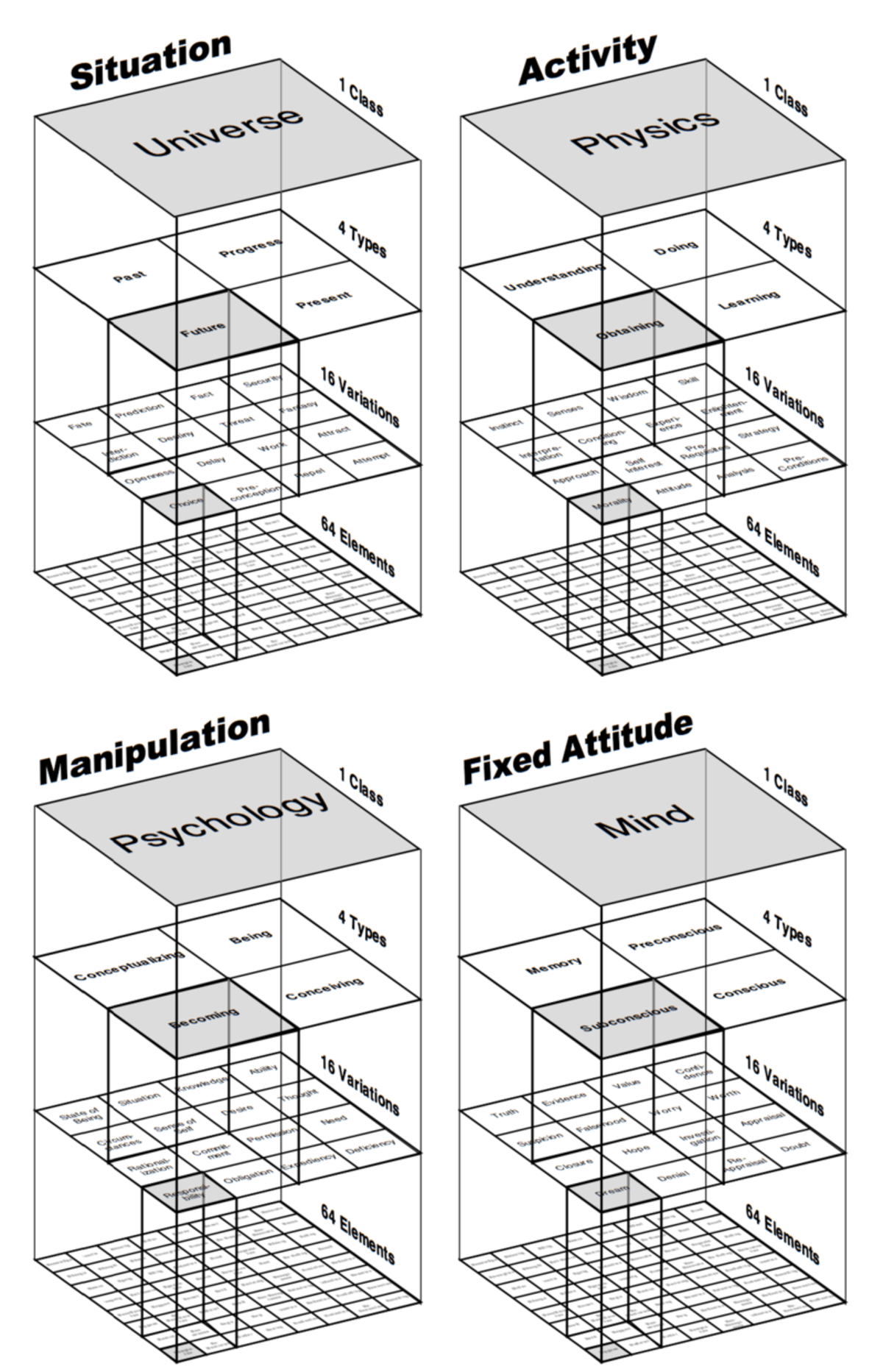
The Basic Concepts Underlying the Dramatica Theory of Story
The formula for predictive psychology
Obfuscation is not always an attempt to mislead. Sometimes, not revealing what's inside the box motivates another to seek out for himself what lies inside. Whether or not one finds something inside relies entirely on that individual's ability to open the box without cutting himself.
Some even give up long before that.
In a ridiculously long post, chemical engineer Goose posits:
I scoured Dramatica Theory and the internet looking for more information or clarity to no avail. This experience leads me to believe two things: either the theory is sound, but is just presented poorly OR the theory is not sound, and the writers compensate by making things vague and confusing (either consciously or not).
The first is accurate, with a dash of the second thrown in for good measure. Dramatica theory is sound, but presented poorly on purpose—the vague and confusing nature obfuscates the specific algorithms and relationships that make up the "special sauce" of Dramatica.
1993 is not 2020. The year of Dramatica's original release knew nothing of open source software or the possibilities of expansion available within the sharing of information. Protection and copyright motivated a modus operandi of keeping those theoretical concepts under lock and key.
Dramatica Theory spectacularly conceals or ignores most of its assumptions, axioms, and logical processes related to the creation and application of the model.
Yes, this is true. The concealment was a factor of both finance and nurture. Growing a revolutionary theory at the outset requires protecting the very nature of its underpinnings. Explain enough of the method to put it into practical use, but don't reveal all for fear of losing everyone right out of the gate.
While some of the questions asked stem from obfuscation, many signal an inability to think soundly about the nature of inequity and perspective.
Imagine the fear and panic if the totality of all remained on the table.
The definitions of words give little indication of what the word represents in the model logically, or the reason for its particular placement.
This problem I can explain.
Dramatica's original pitch targeted Hollywood. Revolutions require funding, and at the time, Software as a Service systems did not exist. Story theorists and amateur writers were not known to be venture capitalists; the closest thing to seed money were the aspirations of Hollywood's best writers.
Those writers want terminology and definitions closer to how they think and speak in the day to day operations of their work. They don't want to hear about Universe or Prerequisite or Deficiencies—and they certainly don't want to hear that every single quad is the same four Elements:
They just want to know what should happen during the second half of the Second Act.
The Base Quad of Dramatica
Dramatica models the human mind processing an inequity. Part of this process involves categorizing that inequity through the lens afforded by the mechanism of the mind. In other words, we see problems as a result of our minds—problems exist within us, not without.
We perceive four bases outside of our minds:
- Mass
- Energy
- Space
- Time
We perceive only these four as a function of our mind's internal bases:
- Knowledge
- Thought
- Ability
- Desire
These two groups correlate with one another, such that:
- Mass is Knowledge
- Energy is Thought
- Space is Ability
- Time is Desire
We see Mass because of Knowledge; we appreciate Energy as an external representation of Thought. Ability and Desire are often harder to see as Space and Time until you understand strengths as the spatial relationship between chunks of Knowledge, and desires as Thoughts that evolve over Time.

We make our world, seeing the Universe as we are, not as it truly is.
And that's precisely how we write stories.
Dramatica just makes it easier to understand how it all works together.
The Mental Math Behind the Theory
The magical feature of Dramatica is its ability to predict Storybeats within a story. Given a set of Narrative Dynamics and a focal point of consideration, Dramatica outlines the steps needed to progress from beginning to end. That story you've been struggling to write for three years? Dramatica helps you cut that time down to three months—including the final product.
This ability to predict narrative lies in a mathematical equation that many find themselves already familiar with every day.
A quad has four corners occupying a square. In accordance with the theory, we give the symbol "A" for the top left that represents "external state", "B" for the bottom right that represents "internal state", "C" for the top right that represents "external process", and "D" for the bottom left that represents "internal process". For example, in the topmost Class stage, A = Universe, B = Fixed attitude, C = Activity, and D = Psychology.
It would be easier to replace these with Dramatica's four base Elements of Knowledge, Thought, Ability, and Desire—but I present both to continue the conversation:
How are A, B, C, and D related? I remember reading something about a pseudo-mathematic equation of A/B = CD, which supposedly means that "when A and B are separated, then C and D are blended" or something.
Yes, this is correct. While not strictly a mathematical equation in the Male sense of 2 + 2 = 4, the idea that one side of the quad dividing balances out with the other side multiplying (blending) holds true in a Holistic sense.
We are talking about the mind here.
The equation does not make sense to me. I do not understand the logic or the apparent psychology behind it.
For a second, let's transpose our perception of the Universe onto Dramatica's base quad of Elements:
And now let's take these observable bases of the Universe and graft them onto Dramatica's equation that is "supposedly" mathematical:
M/E = S*T
And now, let's solve for E:
E = (S*T) M
Hmm. I think I'd like it better if I move the M in front of the S and T...and you know what? S and T are just the same things—a constant, if you will—so let's write the equation out like this instead:
E = mc2
Look familiar?
Einstein blends Space and Time into a constant because that's what a Male mindset does with Ability and Desire—it combines them such that it becomes difficult to think of them as separate.
Ever ask a Male thinker to explain his feelings? Ever wonder why he wants something so badly, yet the moment he has it, he no longer wants it anymore?
That's why Einstein blended Space and Time into a constant.
And that's how Dramatica predicts the Storybeats of a story.
A Model of Relationships
When dealing with the relationships between items in a given context, a conceptual understanding of mathematics helps to describe the elements within a function.
2.What's the deal with the equation A/B = CD? How is it that when an "external state" is separated from an "internal state" that an "external process" will blend with an "internal process"?
Dramatica is a model of relationships. As much as the Male mindset would prefer this relationship to be strictly cause and effect, experience requires something much more comprehensive.
When looking at one Method within a quad of Methods, one must appreciate all four at once. To isolate one or two to the exclusion of others is to obliterate any utility from the Method. When considering the quad of Methods underneath Universe, Past and Present are seen as separate, whereas Progress and Future appear blended. You never know where one starts, and the other begins.
Dramatica mainly focuses on the relationships between A, B, C, and D of a quad through Dynamic, Companion, and Dependent Pairs. The Dynamic Pair states that the diagonal items in a quad contrast the most. So, "A" representing "external state" is most opposed to "B" representing "internal state". The "C" representing "external process" is most opposed to "D" representing "internal process". Therefore a Dynamic Pair contains items of the same motion (state) but different position (external and internal).
You conflate the essential properties of a Dramatica quad with contextual references of dynamics (motion) and location (position). One is not "in motion" (process) and another not (static), any more than light is either a particle or a wave. Both exist simultaneously, the perspective from which one appreciates the quad defines their "motion." Same with external and internal—they both live at the same time in what many refer to as projection.
How do the logic of Dynamic, Companion, and Dependent Pairs make sense according to motion and position? Why is an "external state" most opposed to an "internal state" instead of an "internal process"? Am I way off with this motion/position thing?
Yes, way off (see above).
The current model is Knowledge-based. This bias implies two things: a) Knowledge sits in the upper left-hand corner of the quad, and b) appreciable meaning is a function of Knowledge.
You need a bias when searching for meaning, a context from which to understand up from down. The original version of Dramatica chose Knowledge as its given as that bias more closely aligns with Western Male thought.
In the West, you either Know it, or you don't.
Your giant post of Opinions, Hunches, and Thoughts about Dramatica is an example of what it's like to be blinded by Knowledge. Assuming your place of origin to be somewhere in the West (99.999% sure), I see example after example of someone justifying a line of questioning from a basis of certainty.
One of these biases is the assumption of opposites. To you, a light switch is on or off—you fail to the dynamic transition between on and off.
Part of this preconception can be seen in your assumption of motion and position (moving, yes or no? Inside or out?), but it also appears in your misunderstanding of what it means to be a dynamic opposite. To you, antithesis is a function of on or off, not a more comprehensive appreciation of relationships between items.
If what I assume that what I Know is indeed true, then my Desires are not the dynamic opposite of that Knowledge. The two might exhibit Dependent behavior with one another, but they exist in tandem. Some Know the world to be flat. This Knowledge is a tremendous source of happiness for them and draws them to want to be with others who know the same. Dynamic conflict is not present in this relationship—Knowledge is an external state of mind, Desire is an internal process.
Likewise, if what I assume to Know is true, then my Abilities only serve to amplify or diminish that Knowledge. Knowledge and Ability are Companions within the mind. Kobe Bryant knew he was the best from the age of six. His natural talents (Abilities) only amplified that Knowledge, taking it to a level unheard of in professional basketball (the Black Mamba moniker). And that Knowledge drove him to remove the Ability for other players to touch the ball. Both Knowledge and Ability worked in tandem within Kobe to make him one of the greats.
Dynamic conflict is not present within the relationship between Knowledge and Ability—Knowledge is an external state, and Ability is an external process of the mind.
Knowledge and Thought, however, are directly opposed—especially when Knowledge is assumed to be true (re your post).
You Know static and process to be a function of motion, yet when presented with a different way of Thinking about them, you spend hours and hours writing the ultimate shaggy-dog post of a question. Your criticism is Dynamic Conflict manifest—a result of an external state of the mind Knowledge clashing with an internal state of the mind Thought.
Thought is not a process; one thinks or thinks not.
Knowledge and Thought in the mind collide the same way that Mass and Energy do in the universe. Direct enough Energy and you can shatter a seemingly impenetrable Mass.
The same process occurs in the mind: you may Know something to be impenetrably true—but direct enough Thought towards it, and you can burst through those preconceptions.
But not all Dynamic Conflict is deleterious; Knowledge and Thought combine to manifest even greater Knowledge in the same way that iron sharpens iron:
As iron sharpens iron, one man sharpens another (Proverbs 27:17)
Pretty much describes this additive result of conflict between Knowledge and Thought. This article and the hundreds before it sharpen the iron of other writers.
Conflict is not a function of opposites. When Knowledge is taken for granted, the most significant source of conflict for it is Thought. Abilities and Desires work in concert with Knowledge, supporting through companionship and dependencies.
The Restrictive Size of a Mind
Developing an accurate model of the mind requires an appreciation of scope.
I also do not understand the recursive nature of quads. Based on Dramatica, it seemed clear to me that the quads simply got smaller and smaller within each other. So, the top right item of the Class quad could actually be subdivided into a whole new Type quad, and then the Variation quads, and finally the Elemental quads containing 256 items total (though only 64 unique ones). Why do we stop at Elements and not go further?
We stop at the Elements because of what Dramatica refers to as the Size of Mind Constant. When holding a single context, our minds perceive seven items, plus or minus two. Miller's famous 1956 article "The Magical Number Seven" describes this observation of short-term memory:
people's maximum performance on one-dimensional absolute judgement can be characterized as an information channel capacity with approximately 2 to 3 bits of information, which corresponds to the ability to distinguish between four and eight alternatives.
The Dramatica Table of Story Elements and its four levels of magnification represents the totality of what our minds can retain all at once. You can dive deeper into the Elements—but then you lose sight of the top. Practically speaking, this is what happens within a television series. The series itself tells of one story, while the individual seasons and sometimes episodes explore those Elements as if they were their own story.
Consider both the quad of Mass, Energy, Space, and Time and the quad of Knowledge, Thought, Ability, and Desire. Now, stand on one as a given from which to appreciate the others—and you see evidence of Miller's law beyond pure coincidence.
Why are the Elements the building blocks of this model? It is not entirely clear to me, but I assume it has something to do with balancing the idea of "four" in the model.
Assuming the Elements to be the building blocks is a spatial misinterpretation of the visual representation of the Dramatica model. The Elements are not the "foundation" of the towers. Those towers are a misrepresentation as well—the actual model is collapsed in on itself—a singularity of the mind.
I initially thought that maybe the Elements were the building blocks because at that point our four towers of quads (Universe, Activity, Psychology, and Mind) converged. Once we got to the Element stage, all of the sudden our items in the quads repeated. In fact the 64 Elements generated in one Class are the same as the Elements generated in another. But wait, why do the 64 elements repeat at this level? There doesn't seem to be a reason for it (more on this later).
Those repeated 64 Elements should indeed be 256 separate Elements. Two reasons why they are not: 1) if they were distinct, Authors would undoubtedly miss the connections between subjective and objective points of view, a vital aspect of wrapping one's head around the Premise of a story. 2) define the difference between Pursuit in the context of Physics compared to Pursuit in terms of Psychology. Compound that with a different word for Pursuit within a framework of Universe, and another within Mind. An intellectual exercise to be sure but one that most likely would not be worth the effort.
The quad has four items (from the motion and position dimensions) and there are four viewpoints; therefore, everything must be four in order to maintain balance. The model must only have four levels of recursive quads. This may have been exacerbated by the four established literary terms: character, theme, plot, and genre.
Not exacerbated—corroborated. Validated. The idea that for centuries, we naturally subdivided narrative in terms of character, plot, theme, and genre only supports the concept that we see the world as we are, not as it truly is. Stories are a reflection of how we think-and Dramatica models that process.
But desire of balance is not a logical argument, but instead a satisfaction of our psyche.
Exactly!
Einstein desired one equation to describe the Universe, but that doesn't mean one exists.
I agree. The question to ask yourself is, how can we possibly describe the Universe with one equation if the very tool we use to describe it is hampered by three-bit technology?
We can't.
So instead, we write stories.
Download the FREE e-book Never Trust a Hero
Don't miss out on the latest in narrative theory and storytelling with artificial intelligence. Subscribe to the Narrative First newsletter below and receive a link to download the 20-page e-book, Never Trust a Hero.



